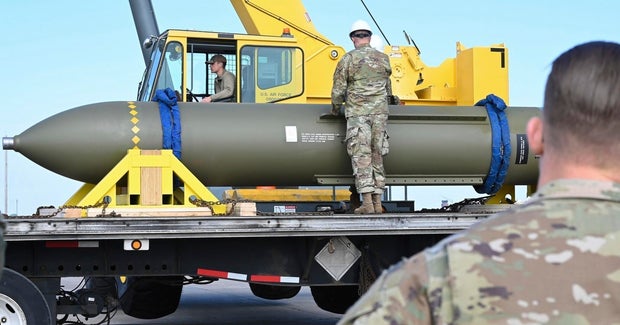
Israel’s strikes against Iran have killed a number of its top nuclear scientists and battered its nuclear facilities, but complete destruction of Iran’s ability to make weapons-grade uranium is believed to be out of reach — unless the U.S. agrees to help.
At least one key uranium enrichment site, Fordo, has so far been unscathed. Located 300 feet beneath a mountain and protected by Russian-produced air defenses, Fordo is believed by military experts to be key to Iran’s nuclear program. Nuclear non-proliferation experts say this is where Iran has tried to enrich uranium for weapons purposes and expand its stockpile of enriched uranium.
Israel’s best chance at destroying the facility at Fordo could lie with a U.S.-produced bomb that’s so heavy that it can only be dropped by a U.S. plane. At a hearing Wednesday, Democratic Sen. Jeanne Shaheen of New Hampshire raised this with Defense Secretary Pete Hegseth.
“It’s being reported that the president is being asked to consider providing the bunker-buster bomb that is required to be carried only by the B-2 Bomber and would require a U.S. pilot,” she said, asking Hegseth whether he had been asked to provide President Trump with options for striking the Middle East. He declined to answer.
Mr. Trump is considering joining Israel’s offensive against Iran, and approved attack plans Tuesday, but has not made a final decision, CBS News has reported. The White House said Thursday that the president would make a decision on whether to order a strike within the next two weeks. Sources told CBS News that the president had discussed the logistics of using bunker-buster bombs as he weighs whether to wade into the conflict between Iran and Israel.
Massive Ordnance Penetrator bomb
The bomb that Shaheen was referring to is the GBU-57 Massive Ordnance Penetrator, known as a MOP. It is designed to attack “deeply-buried facilities and hardened bunkers and tunnels,” according to the Air Force. It’s guided by military GPS and is meant to reach and destroy targets in well-protected facilities.
The MOP measures about 20.5 feet in length and 31.5 inches in diameter, according to the Air Force.
It weighs in at just under 30,000 pounds, including about 5,300 pounds of explosive material. The Air Force says that the MOP’s explosive power is over 10 times that of its predecessor, the BLU-109.
It’s designed to penetrate up to 200 feet underground before exploding. The warhead is encased in a special high-performance steel alloy, which is meant to enable it to carry a large explosive payload while maintaining the penetrator case’s integrity during impact, according to an Air Force fact sheet.
Boeing developed the GBU-57, and as of 2015, the aerospace company had been contracted to produce 20 of them, according to the Air Force.
Because of the GBU-57’s weight — it’s the heaviest bomb produced by the U.S. — the B-2 Spirit is currently the only aircraft in the Air Force that is equipped to carry and deploy it.
B-2 Spirit
One of the key attributes of the B-2 Spirit is its stealth — it’s able to evade air defenses and reach heavily defended targets. It’s aerodynamically efficient and its internal weapons bays can carry two of the GBU-57 bombs.
Because of what the Air Force refers to as the plane’s “low-observable technologies,” the B-2 Spirit has a “high level of freedom of action at high altitudes.” It’s built with a combination of “reduced infrared, acoustic, electromagnetic, visual and radar signatures.” This, along with composite materials, special coatings, wing design and other classified processes, make the B-2 difficult for even the most sophisticated defense systems to detect and track.
Without refueling, its range is about 6,000 nautical miles.
The B-2 took its first flight in 1989, in California, but now, Whiteman Air Force Base, in Missouri, is the only B-2 base. It’s been used for airstrikes in the Kosovo War, in Afghanistan and in Iraq. The prime contractor for the B-2 is Northrop Grumman.
For years, some lawmakers and defense experts have suggested that the U.S. provide Israel with GBU-57 bombs and jets capable of carrying them — but the idea is controversial, with critics arguing the move would be provocative.
Source link





